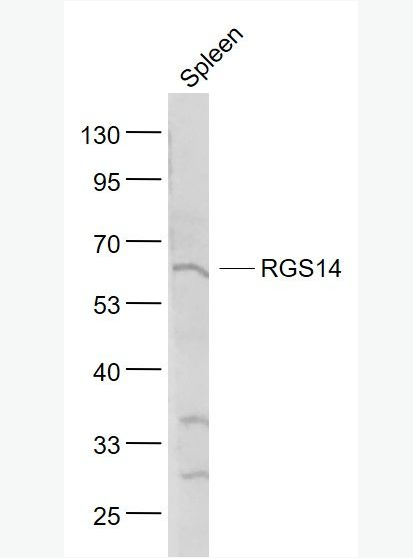| 中文名稱 | G蛋白信號調(diào)節(jié)因子14抗體 |
| 別 名 | Highly similar to rap1/rap2 interacting protein; OTTHUMP00000223586; OTTHUMP00000223587; Regulation of G protein signaling 14; Regulator of G protein signaling 14; Regulator of G protein signalling 14; Regulator of G-protein signaling 14; RGS 14; RGS14; RGS14_HUMAN. |
| 研究領(lǐng)域 | 信號轉(zhuǎn)導(dǎo) G蛋白偶聯(lián)受體 G蛋白信號 |
| 抗體來源 | Rabbit |
| 克隆類型 | Polyclonal |
| 交叉反應(yīng) | Mouse, Rat, (predicted: Human, Cow, ) |
| 產(chǎn)品應(yīng)用 | WB=1:500-2000 ELISA=1:500-1000 IHC-P=1:100-500 IHC-F=1:100-500 ICC=1:100-500 IF=1:100-500 (石蠟切片需做抗原修復(fù)) not yet tested in other applications. optimal dilutions/concentrations should be determined by the end user. |
| 分 子 量 | 61kDa |
| 細(xì)胞定位 | 細(xì)胞核 細(xì)胞漿 細(xì)胞膜 |
| 性 狀 | Liquid |
| 濃 度 | 1mg/ml |
| 免 疫 原 | KLH conjugated synthetic peptide derived from human RGS14 :151-250/566 |
| 亞 型 | IgG |
| 純化方法 | affinity purified by Protein A |
| 儲 存 液 | 0.01M TBS(pH7.4) with 1% BSA, 0.03% Proclin300 and 50% Glycerol. |
| 保存條件 | Shipped at 4℃. Store at -20 °C for one year. Avoid repeated freeze/thaw cycles. |
| PubMed | PubMed |
| 產(chǎn)品介紹 | This gene encodes a member of the regulator of G-protein signaling family. This protein contains one RGS domain, two Raf-like Ras-binding domains (RBDs), and one GoLoco domain. The protein attenuates the signaling activity of G-proteins by binding, through its GoLoco domain, to specific types of activated, GTP-bound G alpha subunits. Acting as a GTPase activating protein (GAP), the protein increases the rate of conversion of the GTP to GDP. This hydrolysis allows the G alpha subunits to bind G beta/gamma subunit heterodimers, forming inactive G-protein heterotrimers, thereby terminating the signal. Alternate transcriptional splice variants of this gene have been observed but have not been thoroughly characterized. [provided by RefSeq, Jul 2008]. Function: Acts as a regulator of G protein signaling (RGS). Modulates G protein alpha subunits nucleotide exchange and hydrolysis activities by functioning either as a GTPase-activating protein (GAP), thereby driving G protein alpha subunits into their inactive GDP-bound form, or as a GDP-dissociation inhibitor (GDI). Confers GDI activity on G(i) alpha subunits GNAI1 and GNAI3, but not G(o) alpha subunit GNAO1 and G(i) alpha subunit GNAI2. Confers GAP activity on G(o) alpha subunit GNAI0 and G(i) alpha subunits GNAI2 and GNAI3. May act as a scaffold integrating G protein and Ras/Raf MAPkinase signaling pathways. Inhibits platelet-derived growth factor (PDGF)-stimulated ERK1/ERK2 phosphorylation; a process depending on its interaction with HRAS1 and that is reversed by G(i) alpha subunit GNAI1. Acts as a positive modulator of microtubule polymerisation and spindle organization through a G(i)-alpha-dependent mechanism. Plays a role in cell division. Probably required for the nerve growth factor (NGF)-mediated neurite outgrowth. May be involved in visual memory processing capacity and hippocampal-based learning and memory. Subunit: Interacts with GNAO1 and GNAI2. Interacts (via RGS and GoLoco domains) GNAI1; the interaction occurs in the centrosomes. Interacts with RABGEF1; the interactions is GTP-dependent. Interacts with RAP2A; the interactions is GTP-dependent and does not alter its function on G(i) alpha subunits either as GAP or as GDI. Associates with microtubules. Found in a complex with at least BRAF, HRAS1, MAP2K1, MAPK3 and RGS14. Interacts with RIC8A (via C-terminus). Interacts (via RBD 1 domain) with HRAS1 (active GTP-bound form preferentially). Interacts (via RBD domains) with BRAF (via N-terminus); the interaction mediates the formation of a ternary complex with RAF1. Interacts (via RBD domains) with RAF1 (via N-terminus); the interaction mediates the formation of a ternary complex with BRAF. Interacts with KRAS (active GTP-bound form preferentially), MRAS (active GTP-bound form preferentially), NRAS (active GTP-bound form preferentially) and RRAS (active GTP-bound form preferentially). Interacts with GNAI1 (via active GTP-or inactive GDP-bound forms); the interaction prevents association of RGS14 with centrosomes or nuclear localization. Interacts with GNAI2. Interacts with GNAI3 (via active GTP- or inactive GDP-bound forms); the interaction prevents association of RGS14 with centrosomes or nuclear localization (By similarity). Associates with microtubules. Subcellular Location: Nucleus (By similarity). Nucleus, PML body (By similarity). Cytoplasm. Membrane (By similarity). Cell membrane (By similarity). Cytoplasm, cytoskeleton, centrosome (By similarity). Cytoplasm, cytoskeleton, spindle. Cytoplasm, cytoskeleton, spindle pole (By similarity). Cell projection, dendrite (By similarity). Cell projection, dendritic spine (By similarity). Cell junction, synapse, postsynaptic cell membrane, postsynaptic density (By similarity). Note=Associates with the perinuclear sheaths of microtubules (MTs) surrounding the pronuclei, prior to segregating to the anastral mitotic apparatus and subsequently the barrel-shaped cytoplasmic bridge between the nascent nuclei of the emerging 2-cell embryo. Localizes to a perinuclear compartment near the microtubule-organizing center (MTOC). Expressed in the nucleus during interphase and segregates to the centrosomes and astral MTs during mitosis. Relocalizes to the nucleus in PML nuclear bodies in response to heat stress. Colocalizes with RIC8A in CA2 hippocampal neurons. Localizes to spindle poles during metaphase. Shuttles between the nucleus and cytoplasm in a CRM1-dependent manner. Recruited from the cytosol to the plasma membrane by the inactive GDP-bound forms of G(i) alpha subunits GNAI1 and GNAI3. Recruited from the cytosol to membranes by the active GTP-bound form of HRAS1. Colocalizes with G(i) alpha subunit GNAI1 and RIC8A at the plasma membrane. Colocalizes with BRAF and RAF1 in both the cytoplasm and membranes (By similarity). Post-translational modifications: Phosphorylated by PKC. Phosphorylation is increased in presence of forskolin and may enhance the GDI activity on G(i) alpha subunit GNAI1 (By similarity). Similarity: Contains 1 GoLoco domain. Contains 2 RBD (Ras-binding) domains. Contains 1 RGS domain. SWISS: O43566 Gene ID: 10636 Database links: Entrez Gene: 10636 Human Entrez Gene: 51791 Mouse Entrez Gene: 114705 Rat Omim: 602513 Human SwissProt: O43566 Human SwissProt: P97492 Mouse SwissProt: O08773 Rat Unigene: 9347 Human Unigene: 1426 Mouse Unigene: 9795 Rat Important Note: This product as supplied is intended for research use only, not for use in human, therapeutic or diagnostic applications. |
| 產(chǎn)品圖片 | 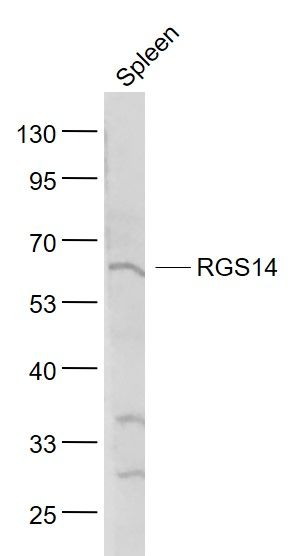 Sample: Sample:Spleen (Mouse) Lysate at 40 ug Primary: Anti- RGS14 (bs-15502R) at 1/1000 dilution Secondary: IRDye800CW Goat Anti-Rabbit IgG at 1/20000 dilution Predicted band size: 61 kD Observed band size: 61 kD  Sample: Sample:Spleen (Mouse) Lysate at 40 ug Primary: Anti- RGS14 (bs-15502R) at 1/1000 dilution Secondary: IRDye800CW Goat Anti-Rabbit IgG at 1/20000 dilution Predicted band size: 61 kD Observed band size: 61 kD 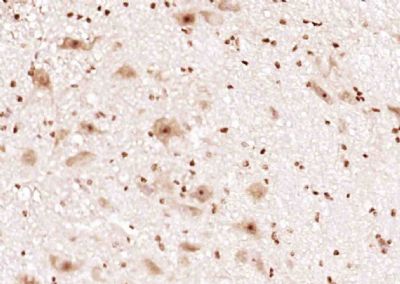 Paraformaldehyde-fixed, paraffin embedded (mouse cerebellum); Antigen retrieval by boiling in sodium citrate buffer (pH6.0) for 15min; Block endogenous peroxidase by 3% hydrogen peroxide for 20 minutes; Blocking buffer (normal goat serum) at 37°C for 30min; Antibody incubation with (RGS14) Polyclonal Antibody, Unconjugated (bs-15502R) at 1:200 overnight at 4°C, followed by operating according to SP Kit(Rabbit) (sp-0023) instructionsand DAB staining. Paraformaldehyde-fixed, paraffin embedded (mouse cerebellum); Antigen retrieval by boiling in sodium citrate buffer (pH6.0) for 15min; Block endogenous peroxidase by 3% hydrogen peroxide for 20 minutes; Blocking buffer (normal goat serum) at 37°C for 30min; Antibody incubation with (RGS14) Polyclonal Antibody, Unconjugated (bs-15502R) at 1:200 overnight at 4°C, followed by operating according to SP Kit(Rabbit) (sp-0023) instructionsand DAB staining. Paraformaldehyde-fixed, paraffin embedded (mouse cerebellum); Antigen retrieval by boiling in sodium citrate buffer (pH6.0) for 15min; Block endogenous peroxidase by 3% hydrogen peroxide for 20 minutes; Blocking buffer (normal goat serum) at 37°C for 30min; Antibody incubation with (RGS14) Polyclonal Antibody, Unconjugated (bs-15502R) at 1:200 overnight at 4°C, followed by operating according to SP Kit(Rabbit) (sp-0023) instructionsand DAB staining. Paraformaldehyde-fixed, paraffin embedded (mouse cerebellum); Antigen retrieval by boiling in sodium citrate buffer (pH6.0) for 15min; Block endogenous peroxidase by 3% hydrogen peroxide for 20 minutes; Blocking buffer (normal goat serum) at 37°C for 30min; Antibody incubation with (RGS14) Polyclonal Antibody, Unconjugated (bs-15502R) at 1:200 overnight at 4°C, followed by operating according to SP Kit(Rabbit) (sp-0023) instructionsand DAB staining.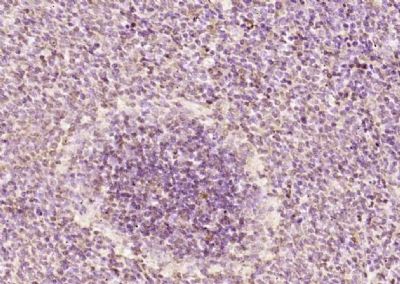 Paraformaldehyde-fixed, paraffin embedded (rat spleen); Antigen retrieval by boiling in sodium citrate buffer (pH6.0) for 15min; Block endogenous peroxidase by 3% hydrogen peroxide for 20 minutes; Blocking buffer (normal goat serum) at 37°C for 30min; Antibody incubation with (RGS14) Polyclonal Antibody, Unconjugated (bs-15502R) at 1:200 overnight at 4°C, followed by operating according to SP Kit(Rabbit) (sp-0023) instructionsand DAB staining. Paraformaldehyde-fixed, paraffin embedded (rat spleen); Antigen retrieval by boiling in sodium citrate buffer (pH6.0) for 15min; Block endogenous peroxidase by 3% hydrogen peroxide for 20 minutes; Blocking buffer (normal goat serum) at 37°C for 30min; Antibody incubation with (RGS14) Polyclonal Antibody, Unconjugated (bs-15502R) at 1:200 overnight at 4°C, followed by operating according to SP Kit(Rabbit) (sp-0023) instructionsand DAB staining. Paraformaldehyde-fixed, paraffin embedded (rat spleen); Antigen retrieval by boiling in sodium citrate buffer (pH6.0) for 15min; Block endogenous peroxidase by 3% hydrogen peroxide for 20 minutes; Blocking buffer (normal goat serum) at 37°C for 30min; Antibody incubation with (RGS14) Polyclonal Antibody, Unconjugated (bs-15502R) at 1:200 overnight at 4°C, followed by operating according to SP Kit(Rabbit) (sp-0023) instructionsand DAB staining. Paraformaldehyde-fixed, paraffin embedded (rat spleen); Antigen retrieval by boiling in sodium citrate buffer (pH6.0) for 15min; Block endogenous peroxidase by 3% hydrogen peroxide for 20 minutes; Blocking buffer (normal goat serum) at 37°C for 30min; Antibody incubation with (RGS14) Polyclonal Antibody, Unconjugated (bs-15502R) at 1:200 overnight at 4°C, followed by operating according to SP Kit(Rabbit) (sp-0023) instructionsand DAB staining.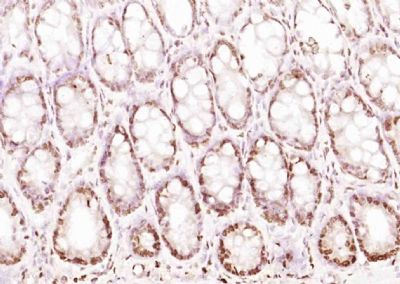 Paraformaldehyde-fixed, paraffin embedded (rat colon); Antigen retrieval by boiling in sodium citrate buffer (pH6.0) for 15min; Block endogenous peroxidase by 3% hydrogen peroxide for 20 minutes; Blocking buffer (normal goat serum) at 37°C for 30min; Antibody incubation with (RGS14) Polyclonal Antibody, Unconjugated (bs-15502R) at 1:200 overnight at 4°C, followed by operating according to SP Kit(Rabbit) (sp-0023) instructionsand DAB staining. Paraformaldehyde-fixed, paraffin embedded (rat colon); Antigen retrieval by boiling in sodium citrate buffer (pH6.0) for 15min; Block endogenous peroxidase by 3% hydrogen peroxide for 20 minutes; Blocking buffer (normal goat serum) at 37°C for 30min; Antibody incubation with (RGS14) Polyclonal Antibody, Unconjugated (bs-15502R) at 1:200 overnight at 4°C, followed by operating according to SP Kit(Rabbit) (sp-0023) instructionsand DAB staining. Paraformaldehyde-fixed, paraffin embedded (rat colon); Antigen retrieval by boiling in sodium citrate buffer (pH6.0) for 15min; Block endogenous peroxidase by 3% hydrogen peroxide for 20 minutes; Blocking buffer (normal goat serum) at 37°C for 30min; Antibody incubation with (RGS14) Polyclonal Antibody, Unconjugated (bs-15502R) at 1:200 overnight at 4°C, followed by operating according to SP Kit(Rabbit) (sp-0023) instructionsand DAB staining. Paraformaldehyde-fixed, paraffin embedded (rat colon); Antigen retrieval by boiling in sodium citrate buffer (pH6.0) for 15min; Block endogenous peroxidase by 3% hydrogen peroxide for 20 minutes; Blocking buffer (normal goat serum) at 37°C for 30min; Antibody incubation with (RGS14) Polyclonal Antibody, Unconjugated (bs-15502R) at 1:200 overnight at 4°C, followed by operating according to SP Kit(Rabbit) (sp-0023) instructionsand DAB staining. |
我要詢價
*聯(lián)系方式:
(可以是QQ、MSN、電子郵箱、電話等,您的聯(lián)系方式不會被公開)
*內(nèi)容:


